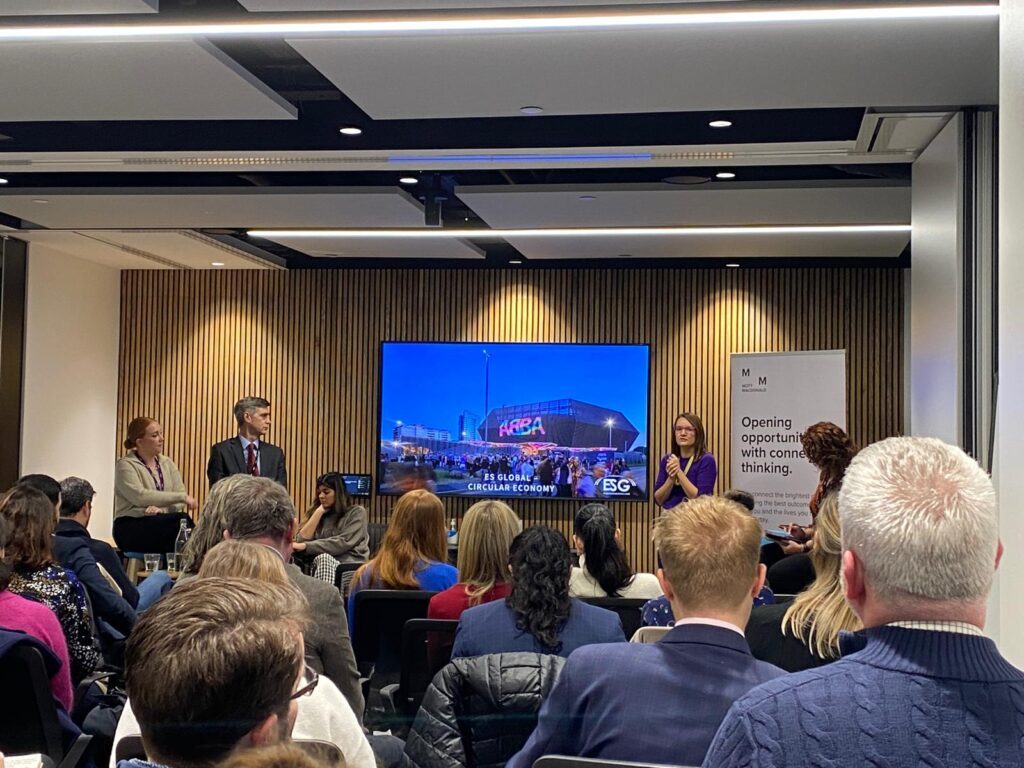
Insight
Unlocking the Circular Economy in the Built Environment
As an industry, we’re still in the nascent stages of how materials reuse can fully unlock building efficiency and the reduction of building waste for the sake of cost and carbon. On Thursday 29th February, Amy Casterton, ES GLOBAL’s Director of Business Development spoke at Mott McDonald’s Unlocking the Circular Economy in the Built Environment breakfast event.
What is apparent, is that with so many creative ideas at play, and some of the UK’s best thinkers on the job, we need to work together to make it a systems- thinking approach.
Speaking after hosts Mott McDonald’s Mark Enzer OBE FREng and Charlotte Garrett from KOPE (pioneering digital solutions), Amy rounded off the presentations with an overview of key ES GLOBAL case studies demonstrating the best in circular design.
Our ethos that has underpinned the specialism of our work in relocatable architecture across sectors such as major events, sports, and increasingly in the public sector/healthcare.
In a nod to the health of the demand for temporary staging, Amy was able to share that “We did the first Live Aid stage, Harry Styles and P!nk’s concert last year, and we have many more stages going up this year. Those are inherently circular structures.” This is due to the fact they flatpack, are steel-trussed and pin together.
But as ES GLOBAL has moved into other sectors since our beginnings in the world of rock concert touring, “reusability has remained at the heart of what we do.” Having mapped our work against the UN’s Sustainable Development Goals a couple of years ago, the firm appointed a sustainability manager — a move that was big for a company of 80 people.
Amy moved on to three key case studies to paint a picture of these principles in practice. ES GLOBAL worked directly with ABBA and the architects Stufish, to deliver “a vision for the world’s largest demountable venue”.
‘It was a staggering project to work on and it’s a really fab show – a 270-degree immersive experience with a 70 metre wide span roof.” The venue consists of a lightweight hybrid steel frame structure and is fully flat packable – designed to be moved. Its proximity to the DLR means 85% arrive by public transport, another sustainability win.
Built on a lease contract with LLDC, the public authority that runs the Queen Elizabeth Olympic park, the project was an experiment. Crucially, because ABBA knew they could move it, they didn’t have to design where it was going to go next, but they had to commission a building which could move. That planning and ‘designing in’ future use is key to ES GLOBAL’S circular project delivery approach.
Amy then went on to discuss a turnkey design build project with David Morley architects for the Olympic Delivery Authority — the water polo venue for the London 2012 Olympics.
A modular steel truss provided the wide spans needed for the TV audience and was also naturally aircooled. There was heating for the water but the rest of the building was naturally ventilated through the back of the stands and via a double tensile fabric.
A ‘meanwhile use’ project, the venue was taken down, and used to win a project in Sochi for the Winter Olympics and other parts found a permanent home building a velodrome in Jakarta for the 2018 Asian Games. “As you can see, this permanent venue has an amazing wide span structure, used for cycling but also performances.”
To close up, Amy shared some work in the public sector. “It came out of nowhere in the pandemic — we got a call from Mott McDonald asking us to build a Covid hospital in the Principality Stadium in Cardiff.” The project was conceived within a weekend and delivered within five weeks.
“A really important part of the circular economy is to bring your supply chain with you,” said Amy. “The events industry mobilised really quickly. When you’re doing a show, you have to open on time every time — that’s the ethos we brought to this structure.”
“It’s really interesting to think about future surge requirements. Crisis meets surge meets capital investment – is something that requires an agile response — the RAAC crisis being a good example of this.” What ES GLOBAL has developed is something that can be a permanent facility, but also relocated and reconfigured.
ES GLOBAL uses materials available on the market to maintain agility. “It’s a tool for estate managers that gives them what they need — especially if they’re not sure what they’ll need in 18 months time.”
To close up, Amy said, “we’ve been doing this for 50 years. So when modern methods of construction, and the Construction Playbook first emerged in 2020, from the Government we read that and of course very much welcomed it, but it felt like something we’ve been doing – in our bones – for ages.”
ES GLOBAL is now trying to push harder to respond to end-user needs. “As a responsible design-builder, we should be able to guarantee the reuse and circular life of the products and systems which create the buildings — clients don’t always know what their buildings will be used for in 5 years, it’s our job to respond to that.”
